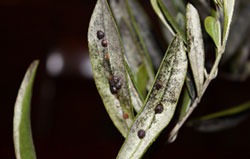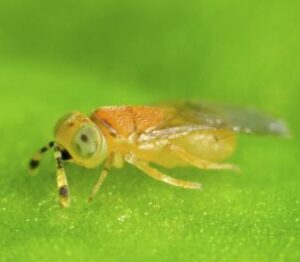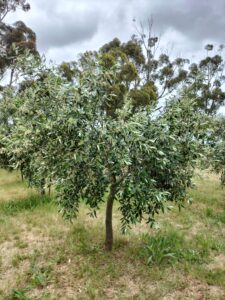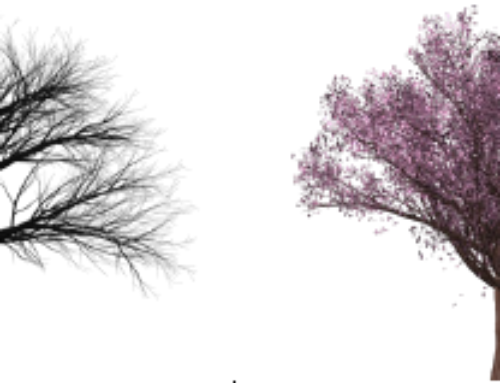Much of the fruit that we receive for processing each year is contaminated by sooty mould. This mould is a by product of a bigger issue; infestation of the trees with scale. In spite of the local weather not quite having reached regular Summer conditions yet, it’s time to start thinking about the control of scale in your olive trees. This post will give you some background on biological and insecticidal controls available and what we use at Apulia Grove.
The Problem

Two generations of scale on olive leaves, with sooty mould present also. (Image source)
Black scale (Saissetia oleae) is a common and widespread pest of olive groves across Australia. The insects suck sap from the leaves and stems of new growth in the olive trees, and secrete a sticky sweet honey dew as a waste product. This honey dew is incredibly attractive as a food source to ants, who will protect the scale from potential predatory insects such as lace wings and ladybug larvae. The honey dew also produces excellent growing conditions for sooty mould, which can be spread by the traffic of the ants around the grove. Dealing with scale always requires an Integrated Pest Management approach for best results, and special focus should be applied to ant control if you plan to make use of releasing biological control agents to manage your scale problem.
The Lifecycle
Adult scale form hard, circular shells on the underside of leaves and the stems of twigs where they feed on the sap. In early December, the eggs begin to hatch and you will be able to see tiny orange or pinkish dots on the underside of leaves, near the mid-vein. This is the best time to apply insecticidal sprays. Depending on local climatic conditions, scale can produce two or three generations within one growing season. Warmer weather induces greater reproductive capacity.
As the insects age, they grow through a series of “instars” or life cycle stages. From hatching, the immature insects are known as “crawlers”. This is the stage at which they move through the canopy and can also disperse through the grove. Crawlers can spread actively under their own power, or passively through transmission on machinery or via the tree movement in the wind. Unfortunately they can be hard to see as the pink/orange dots are only 0.2-0.3mm long.

Crawlers on an upturned scale carapace. (Image source)
Once the crawlers have settled in place on the leaves or the stems of the olive tree, they moult their skin and become “first instars”. From this time forward, the insects will carry out the rest of their life cycle in place. First instars are 0.6-0.75mm long and 0.2-0.35mm wide.
The “second instar” can be identified by a ridge which forms along the length of the pale brown body which shows four distinct darker brown patches. This stage is
The third instar are considerably easier to see, although already starting to form the carapace that protects the mature insects from environmental conditions and insecticidal sprays. They are dark brown all over, with a distinct ridge. They are 1-1.6mm long and 0.5-0.8mm wide.
At maturity, scale develop the hard carapace, under which they lay their eggs and the cycle may begin again if the weather conditions continue warm and stable.
Chemical control
If you prefer organic pest control, horticultural oils like neem oil, paraffinic oil or “white oil” are the only options available. You can make your own white oil at home using one part dishwashing detergent to four parts vegetable oil mixed together and diluted 1 part oil mix to 10 parts water before applying. These oil-based options are broad-spectrum sprays that will kill all insect types, both beneficial and destructive. These sprays work by blocking the breathing apparatus of the insects with a sticky, oily coating. Don’t apply these oil sprays during the heat of the day, or when really sunny weather is forecast as you can roast your trees. Charlie learnt this the hard way one year when he attempted to treat half a dozen of our trees!
If you’re not organically minded, or the problem is extensive and you want something targeted to deal with just the scale insects, there is a great product on the market called “Admiral” which is a hormonal disrupter of the juvenile scale insects. They don’t die immediately, but after spraying, they are unable to reproduce.
Whichever of these options you choose, it’s best to spray one application when you first see the orange/pink dots on the leaves, and another two weeks later, as the eggs will hatch over a period of time and this helps to ensure that all members of the population receive at least one application of insecticide.
Biological control
Black scale is also a major pest of the citrus industry, so much research has gone into finding potential biological controls which can also be released in olive groves. Most recently Metaphycus helvolus and M. lounsburyi were released between 1998 and 2003 in WA as part of a research project funded by Horticulture Australia Ltd. However, these insects failed to establish effectively, and the egg predator Scutellista caerulea was discovered to be the most common scale-specific biological control agent. Unfortunately the effectiveness of S. caerulea is limited because population density doesn’t reach a critical level in conjunction with scale hatching events so outbreaks cannot be prevented in most seasons. Therefore, in spite of their failure to thrive in WA, M. helvolus and M. lounsburyi are the recommended specific biological control agent for black scale. Obtaining these insects commercially can still be a challenge, but general predatory bugs such as lacewings and ladybirds are also of use in controlling scale populations.

Metaphycus spp wasp. (Image source via The Australasian Biological Control Association Inc. (ABC) website)
The Australasian Biological Control Association Inc. (ABC) is a great place to start for all things biological control agents.
How we manage scale at Apulia Grove
Firstly, I cannot understate the importance of pruning the tree canopy. Allowing light and air into the canopy helps to mitigate the spread of sooty mould that is often associated with scale infestations. Having a lesser canopy burden on the tree also allows for better penetration of insecticidal sprays, meaning that you get more bang for your buck (Admiral works really well, but it’s NOT cheap!). So we start by maintaining the canopy at an open density. The images below will give you an idea of what I mean:

Starting height and canopy density for a 15 year old, unirrigated olive tree that had never been pruned.

The same tree after reducing height and establishing production shape to allow light and spray penetration of the canopy, as well as air circulation.
Ant control is managed by keeping the soil mulched with a good quality compost to keep the soil cool and moist. Ants are less active is cool and damp weather, and trees are less susceptible to pest and disease burdens when well fed. Sticky traps on heavily infested trees also help to limit ant traffic and minimise the spread of sooty mould spores.
I see the purchase of biological control agents as an investment in the long term health of our grove and I want to establish a local population of them here on our farm. For this reason, we haven’t yet released any biological control agents, because we are still establishing greater biodiversity in the landscape. This helps to give habitat to the insects at each stage of their lifecycle, so that we don’t have to keep purchasing bugs for release each growing season.
In the meantime, we spray Admiral at carefully monitored times to manage the scale population, and make use of an organically approved cupric hydroxide fungicide to manage the sooty mould from spreading too far.



We had an email question regarding this post, so I thought I’d share my response here for other readers too. The question was, if I can’t see any pests or diseases on my trees, should I use fungicide/insecticide as a preventative spray? And what do we recommend for foliar fertilisers?
My answer: Fungicide can be useful as a preventative measure, if the weather conditions indicate that it may be necessary. Unless your area is expecting hot and humid conditions for more than three days in a row, I wouldn’t bother with fungicide once the main heat of Summer has arrived. It also depends on how open your tree canopy is; if the air flow is good in and around the fruit, I would let nature do her thing.
Insecticides you’re better off using only when/if required as the pests can build up resistance to the chemicals over time. You might like to instigate a pest observation schedule to help you determine if/when insecticide is required? Unfortunately for scale, that usually requires inspecting the leaves with a magnifying glass to see if the crawlers have hatched, but another good pest management option is to do an ant count. You can ring the trees with horticultural glue and see what’s crawling up and down. If there are a lot of ants, you will know to keep an eye out for scale too (the ants farm them for their honeydew secretions).
Foliar fertiliser is never a bad plan as it can help strengthen the tree against predation by insects, and introduce helpful bacteria and fungicides onto the plants to combat unwanted fungal infections (depending on what you’re spraying). I like compost teas for foliar fertilisers, and recommend you check out Elaine Ingham’s work at the Soil Foodweb Institute for more info.
The other spray that might be of use after pruning and during the very bright sunshine season is a lime wash to help protect exposed bark from sunburn. You can mix a tablespoonful of hydrated lime (builders’ lime is fine) into 5L of water and spray that on the tops of the leaves, and along the branches and trunks if they appear to be cracking or looking overly dry in the sun. The most commonly affected bark will be that which is recently exposed due to canopy reduction pruning. When dry, the lime leaves a white powder residue on the plants which helps to reflect the heat and light away from delicate biomass. The pH of the lime can also help to deter fungal infections from taking hold.
My only other comment would be to stop spraying everything at least two weeks before you plan to harvest the fruit. Most of what I recommend is organic assistance to the plants, but it’s good to observe a withholding period just in case.
Hi there I’m looking to help manage our issue of the scale by planting a bit of diversity in the grove. Are you aware of any plantar/ trees that are effective in helping control the insects?
Hi Kerrie, thanks for your question.
It sounds counter-intuitive to grow plants to attract predatory insects, but many of the nymph and larval stages of predatory insects eat nectar or plant sap before becoming carnivorous in their adult life cycle. So planting a cover crop of annual or perennial flowering plants will help attract predatory insects. There are some great seed mixes available; look for things like “Good Bug Mix” from Green Harvest.
What we have found with an IPM approach to scale infestations is that you’ll need to control for ants before trying to improve conditions for or releasing beneficial bugs. This is because the ants will protect the scale, which they use as a source of food (honeydew). Controlling ants can be as simple as banding the worst affected trees with horticultural glue to exclude them from the canopy of your grove. I don’t recommend destroying the nests as ants provide a beneficial service in soil aeration, but if the glue bands show that ant numbers are extreme, you can use borax baits to eradicate nests with minimal broad spectrum damage to my knowledge.
Things you’ll definitely want to avoid planting near your olives are citrus and oleanders as these can provide a winter food source for other pests like olive lace bug, which has been a big problem this year.